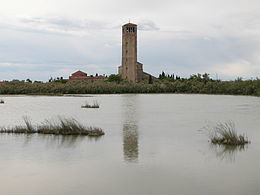Torcello
 View of Torcello | |
| Geography | |
|---|---|
| Coordinates | 45°29′48″N 12°25′02″E / 45.496565°N 12.417313°E |
| Adjacent to | Venetian Lagoon |
| Administration | |
| Region | Veneto |
| Province | Province of Venice |
Torcello (
History
After the downfall of the
Torcello benefited from and maintained close cultural and trading ties with
Torcello rapidly grew in importance as a political and trading centre: in the 10th century it had a population often estimated at 10,000–35,000 people, with 20,000 the most commonly cited estimate.[6] However, some recent estimates by archeologists place it at closer to a maximum of 3,000.[7] In pre-Medieval times, Torcello was a much more powerful trading center than Venice.[8] Thanks to the lagoon’s salt marshes, the salines became Torcello’s economic backbone and its harbour developed quickly into an important re-export market in the profitable east-west-trade, which was largely controlled by Byzantium during that period.[5]
The
As a result, by the late 14th century, a substantial number of people left the island for Murano, Burano or Venice.[5][12] In 1689, the bishopric transferred to Murano, and by 1797, the population had dropped to about 300.[14] It now has a full-time population of just 10 people, including the parish priest, according to some sources,[1] and only 12 in 2018.[15]
Sights
Torcello's numerous
Today's main attraction is the
Another noteworthy sight for tourists is an ancient stone chair, known as Attila's Throne. It has, however, nothing to do with the king of the Huns, but may have been the podestà's or the bishop's chair, or the seat where chief magistrates were inaugurated.[17] Torcello is also home to a Devil's Bridge, known as the Ponte del Diavolo or alternatively the Ponticello del Diavolo (devil's little bridge).
Famous residents
Gallery
-
View of Torcello in a book published in Venice in 1534
-
Central Torcello, with the Cathedral of Santa Maria Assunta and the Church of Santa Fosca
-
Facade of the cathedral.
-
Narthex of the cathedral.
-
Mosaic from the cathedral in the Louvre in Paris.
-
Sculpture of the Museo provinciale di Torcello.
-
Torcello as seen from the Venetian lagoon
-
Venetian lagoon as seen from Torcello
See also
Notes and references
- ^ a b "Torcello, l'isola che sta sparendo Restano dieci abitanti. E un prete". Corriere del Veneto. 28 June 2014. Retrieved 24 December 2014.
- ISBN 9781135948795.
- ^ (Firm), John Murray (1853). A Handbook for Travellers in Northern Italy: Being a Guide to the States of Sardinia, Lombardy and Venice, Parma and Piacenza, Modena, Lucca, and Tuscany as Far as the Val d'Arno. p. 347.
- ^ The Home Encyclopædia: Compiled and Revised to Date from the Leading Encyclopædias. Educational publishing Company. 1895. p. 5870.
- ^ ISBN 0801814456
- ISBN 9781135948795.
- OCLC 883623826.
- ISBN 0679721975.
- ISBN 978-1-55584-843-9.
- ^ State of Texas, Texas Department of State Health Services. "History of Plague". Dshs.state.tx.us. Archived from the original on 11 April 2016. Retrieved 28 March 2009.
- ISBN 0-521-42354-6
- ^ ISBN 9780521154901.
- ^ Alfieri, Bruno (1950). Venice; a Guide to the City of the Lagoon. p. 103.
- ISBN 9781135948801.
- ^ Rogers, Patrick (2018-03-12). "Exploring Venice's Exclusive Private Islands". Town & Country. Retrieved 2020-10-15.
- ^ "Torcello: The Rise and Fall of Venice's Forgotten Rival". decodedpast.com. Archived from the original on 2015-01-13.
- ^ (Firm), John Murray (1853). A Handbook for Travellers in Northern Italy: Being a Guide to the States of Sardinia, Lombardy and Venice, Parma and Piacenza, Modena, Lucca, and Tuscany as Far as the Val d'Arno. p. 349.
- ^ Crevar, Alex (19 February 2006). "Torcello Offers a Refuge From the Tourist Crush". New York Times. Retrieved 24 December 2014.
- ^ "Hotel Cipriani: Our Memories". Locanda Cipriani. Archived from the original on 7 October 2013. Retrieved 24 December 2014.










